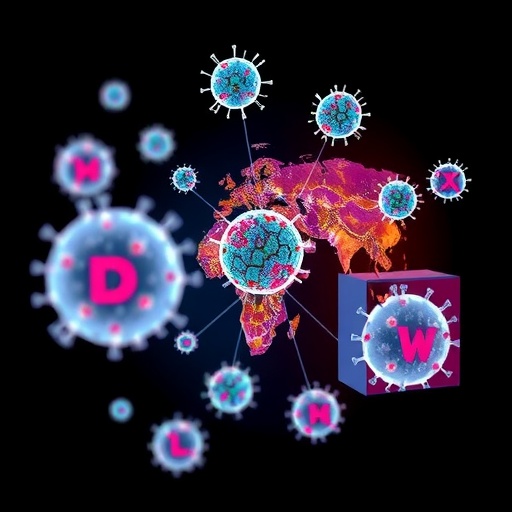
Credit: Photo: Sandra Meyndt
International researchers working in collaboration with Professor Wolfgang R. Hess and Dr. Jens Georg, both from the University of Freiburg's Faculty of Biology, have discovered a small RNA molecule that plays a key role in how cyanobacteria adjust their metabolism to the amount of iron available in the environment. Oxygenic photosynthesis – in which plants, algae and cyanobacteria generate oxygen and harvest solar energy for the synthesis of organic matter – is a process that depends on iron. When only low amounts of iron are available, cyanobacteria are able to reduce their photosynthetic activity by using what the researchers are calling IsaR1, which stands for "iron stress activated RNA 1." The team of researchers have published their findings in the latest issue of Current Biology.
As a result of their dependence on iron, oxygen-producing photosynthetic cells face a twofold dilemma. On the one hand, ferric iron (Fe3+) and oxygen tend to react with each other and form a type of rust that is typically insoluble in an oxygen-rich environment, meaning that the resulting iron compound cannot be used for metabolism. On the other hand, ferrous iron (Fe2+) can lead to the creation of dangerous free radicals by reacting with molecules that are present in every living cell. Iron is therefore an essential but potentially dangerous element, and cells must constantly regulate its status and concentration.
Scientists have known for a long time that many bacteria keep their iron levels stable with the help of a transcription factor called Fur, which stands for "ferric uptake regulator." When sufficient amounts of iron are present, Fur binds it. This enables Fur to act as a repressor, meaning it is inhibitory for the expression of certain genes. If iron starvation occurs, then Fur loses the bound iron atom, enabling the bacteria to produce certain proteins that, for example, ensure the uptake of iron.
When not enough iron is available, the bacteria also have to inhibit the expression of other genes, so that they can stop the production of proteins that are particularly iron-rich and are not absolutely necessary for survival in unfavorable conditions. This is especially true regarding the apparatus for oxygenic photosynthesis, which is the most iron-rich supramolecular structure in the cell. The transcription of the information contained in the DNA involves regulatory RNAs. One of these RNA molecules is IsaR1. When iron is low, IsaR1 affects the photosynthetic apparatus of cyanobacteria in three different ways. First, IsaR1 inhibits the expression of multiple proteins that are important for photosynthesis. Second, IsaR1 interferes with the biochemical pathway leading to the production of the green photosynthetic pigment chlorophyll, which is needed in smaller quantities when iron is scarce. Third, IsaR1 works against the expression of proteins for iron-sulfur clusters, which are also important in photosynthesis.
What is also remarkable is that IsaR1 consists of only 68 nucleotides, as compared to the genes of regulatory proteins, which often need thousands of these building blocks. "Discovering that such a short RNA molecule controls such a major acclimation response in metabolism and thus affects the photosynthetic machinery on three different levels was a great surprise," said Wolfgang Hess. The team's findings not only provide insight into a previously unknown acclimation strategy of photosynthetic cyanobacteria; they also enable researchers to draw key conclusions about the regulation of photosynthetic processes in all "green" organisms, including plants and algae.
###
Background: Cyanobacteria
Microfossils called stromatolites found in Australia have shown that photosynthesizing cyanobacteria are some of the oldest forms of life on Earth. Similar cells even existed already more than three billion years ago. Their photosynthetic activity released oxygen into the atmosphere, where it accumulated over the millennia and ultimately enabled the evolution of animals and humans. Cyanobacteria, especially those in the ocean, continue to play an important role in environmental cycles today.
Publication:
Jens Georg, Gergana Kostova, Linda Vuorijoki, Verena Schön, Taro Kadowaki, Tuomas Huokko, Desirée Baumgartner, Maximilian Müller, Stephan Klähn, Yagut Allahverdiyeva, Yukako Hihara, Matthias E. Futschik, Eva-Mari Aro, Wolfgang R. Hess: Acclimation of Oxygenic Photosynthesis to Iron Starvation Is Controlled by the sRNA IsaR1. Current Biology, DOI 10.1016/j.cub.2017.04.010
Caption:
Microfossils found in stromatolites are proof that photosynthetic cyanobacteria are some of the oldest life forms on earth. This stromatolite from Crete, Greece, is from the Triassic period and is roughly 230 million years old.
Photo: Sandra Meyndt
Source: Geo- and Paleontological Collection, Institute of Earth and Environmental Sciences
Contact:
University of Freiburg
Genetics & Experimental Bioinformatics, Faculty of Biology Genetics & Experimental Bioinformatics, Faculty of Biology
Media Contact
Wolfgang R. Hess
[email protected]
49-761-203-2796
############
Story Source: Materials provided by Scienmag




